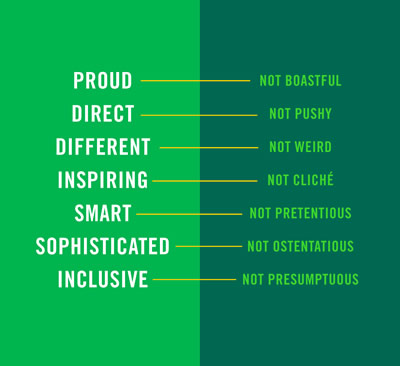Voice and Positioning
If our messaging is what we say, our voice is how we say it.
Together, a compelling message and a consistent voice make the Skidmore College story resonate with the right audiences and set us apart from our peers. In this section, you’ll find guidance to help you achieve this across every communication platform.
POSITIONING STATEMENT
How our story begins to take shape
This statement is a creative expression of the brand strategy and messaging map. It details what Skidmore stands for. It articulates our strong belief in creative thought, and how that thought influences every aspect of life. It speaks to our role in our students’ lives, and gives us a rallying cry to stand behind.
Creative Thought Matters
Creativity is at our core.
It powers the way we think, communicate, and do. We boldly declare that, here at Skidmore, more than anything, Creative Thought Matters.
It matters in the work we do, the actions we take, and the people we are.
Creativity empowers us to combine unconnected ideas, bring them to life, and turn them into solutions. Creativity drives us to uncover new ways to approach everyday challenges. Creativity opens us up to diverse perspectives so that everything we do is bigger, better, and more inclusive.
At Skidmore, no matter that you think you’re meant to be, or do, or create, or inspire — Creative Thought Matters. And that makes all the difference.
POSITIONING STATEMENT
How to use the positioning
If there’s one idea that pervades the Skidmore College experience, it’s the importance we place on creative thought. How we talk about creative thought and how we illustrate it in action can vary, depending on what audience we’re addressing and what content we’re supporting. But it’s always at the core of our story.
Use it to:
GUT-CHECK THE VOICE .
Does the tone of what you’re writing support our differentiating idea of “Creative
Thought Matters?” Does it sound like the personality of a person who embodies it?
STAY ON MESSAGE.
Move beyond facts whenever possible. By illustrating real examples of creative thought
at work in our everyday lives, we tell a richer story, marrying the emotional and
logical aspects of our positioning.
INFLUENCE VISUAL CHOICES.
Incorporating this idea goes beyond a single thought or copy point. It should influence
the design and other visual elements as well.
POSITIONING STATEMENT
How to use the positioning to craft content
Every message we create links back to the positioning in some way. In doing so, each piece of content feels connected and helps flesh out the larger story of Skidmore. Here are just a few examples of how the idea flexes for different aspects of our College’s messaging.
------------------
------------------
PERSONALITY
How our tone and voice take shape
These personality traits play a large role
in how our brand should feel and sound. They help humanize our messages, and make
our communications feel uniquely like Skidmore. When writing, designing, or crafting
any communication, ask yourself if what we’re saying captures the essence of our personality.
CREATIVE
This is the core of who we are. Our creative spirit drives everything we do, leading
us to explore, question, and imagine without fear or boundary.
ECLECTIC
We’re diff erent, and that’s a good thing. Here, people follow their passions and
thrive, because Skidmore accepts and appreciates who they are and what they contribute.
INDEPENDENT
We’re a community of unique individuals who each do our own thing, and we own it.
UPLIFTING
We support one another, and want to create meaningful experiences that make our communities
better.
CONFIDENT
We are unabashedly passionate and know who we are, but we’re also ready to grow
and make new discoveries.
VOICE
How we say it
Our brand voice gives us a recognizable style that’s ours alone.
In connects us with our audiences. It gives our content meaning and relevance. It expresses our personality and reinforces our brand.
Remember, Our Voice is:

CRAFTING COMMUNICATIONS
A few things to keep in mind
- Make it personal.
Use fi rst-person plural and second-person pronouns (“we”/”us” and “you”), where appropriate. This engages your reader in a direct, human way. - Make it clear.
Make only the point you’re trying to make. Every communication won’t contain every detail, so focus on what’s important to the matter at hand. - Make it relevant.
Consult the messaging map when you’re creating communications, and look for places to include key messages. - Make it authentic.
Back up your statements with proof points. Share real, honest stories of the work we’re doing. - Make it readable.
Vary the cadence within communications. Mix short sentences with longer ones to avoid falling into a rut. Check for rhythm and flow by reading passages aloud.
- Make it worthwhile.
Give your reader a reason to care. Lead with audience-specific benefits (what they get) and back them up with our brand attributes (what we offer). - Make headlines work harder.
Headlines should be more than just labels for the subject at hand. Since they may be the only thing our audience reads as they scan the copy, make sure they’re compelling and informative. - Make it relatable.
We write like we speak, aligned with our brand personality. This may occasionally mean breaking a grammar rule or two. Used judiciously, contractions and sentence fragments add personality to communications. - Make it actionable.
Give your audience a clear call to action, so they know exactly what you want them to do. - Make it concise.
Especially when making a direct ask, make each word count.